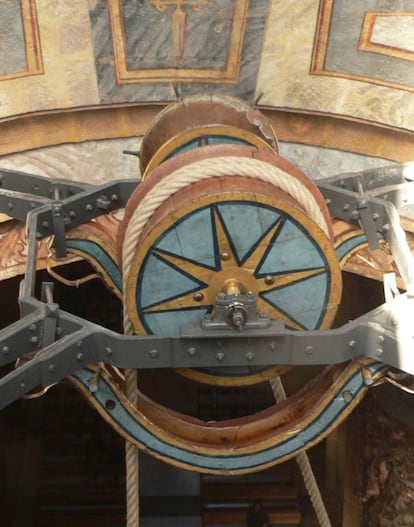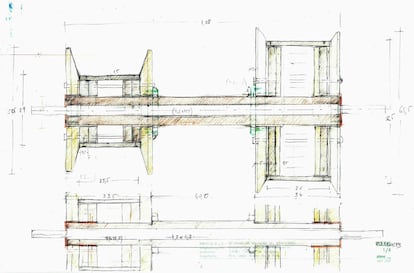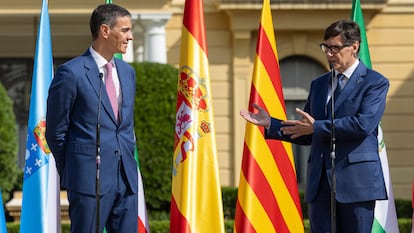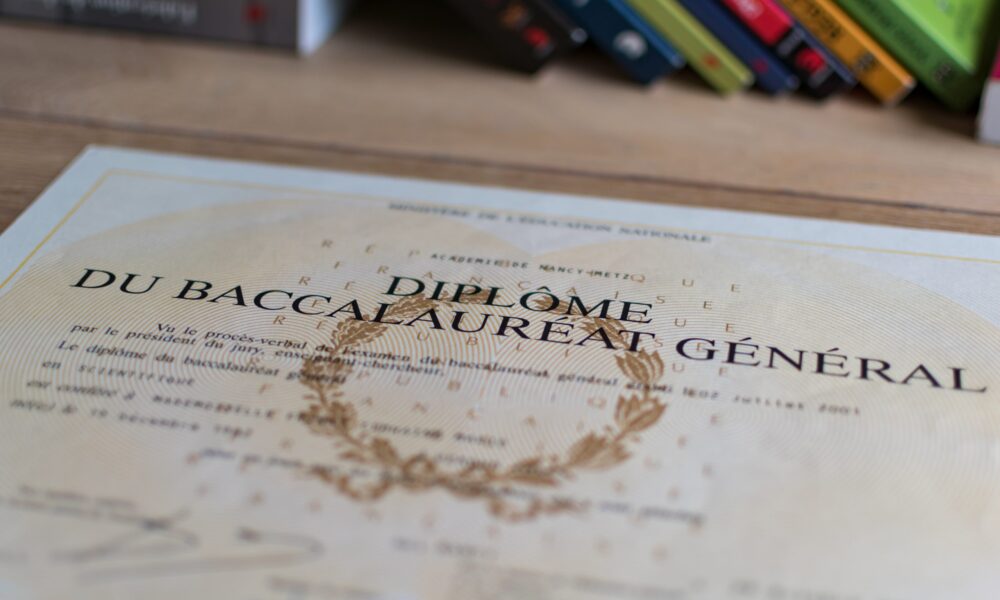The Botafumeiro ingenuity visits the workshop: set up to continue flying another 400 years | Galicia news

A long decade ago he left this world Armando Raposoone of the last mythical beings, there are those who say magic, who inhabited the cathedral of Santiago and knew all their corners and secrets until the cataclysm of the theft of the Calixtino codex forced to put order in this house of the Lord. Now everything is less romantic, but more professional and more technical, and the Cathedral Foundation created then is behind all the works and restorations that have happened at this time. Raposo held Since 1964 the position of Tiraboleiro Mayorthat is, head of the Tiraboleirosthe team of eight men covered with garnet tunic who are the motor force of the Botafumeiro. The Tiraboleiros They are accompanied by the eight ends that form the maroma of this giant censer, a flying artifact that has monopolizing the liturgy show before the main altar of the Compostela Basilica since the Middle Ages. Between flashes, exclamations and applause, pilgrims, tourists, celebrities, monarchs and other officials on the official visit end with their mouths open and celebrate the flight of the metro and a half height. Botafumeiro reaches 68 kilometers per hour pendulating on the heads, and the photos are always from the setter bathed in silver and the Tiraboleiros. The image of Armando Raposo, a small man, braking with his body the flying bowl as if he grabbed a bull by the horns illustrates albums of travelers from all over the planet. But what almost nobody repairs is in the ingenuity that from the top of the main chapel organizes that game of forces that makes possible the Ritual Dance of the censer.
This mechanism located under the Cimborrio works from two years after the Aragonese Juan Bautista Celma in 1602; But in 2024 he spit a screw. It was his particular attention call, from up there. When they got it with a crane, the carpenters and mechanics found that they were worse than they imagined. It had been repaired, without moving it, only four years ago, and in its wood and iron guts other previous interventions made “without coherence”, explains Javier Alonso, architect of the Cathedral Foundationin a video disseminated by the institution these days. So much had to be corrected now, that the tuning of the flight system was extended several months.
He « Ingenio » of the Botafumeiro commissioned by the canons to Celma It consists of two wood drums, one of 29 centimeters in diameter and another of 58, manufactured with boys of walnut and brown. The drums revolve in both directions and operate jointly united by a wooden axis that carries inside another iron with two bearings at the ends. All this is mounted on a metal, also based on the four main Basilica cruise columns. The pendular movement of the Botafumeiro takes place along the transept, or arms of the Latin cross that forms the temple. The first documentary reference for the operation of the great censer appears in a scoring on the margin in the Codex CalixtinusBotafumeiro is cited as « Turibulum Magnum » (and from there « Tiraboleiro »). But the ingenuity that now pilots was ordered to be built by the cathedral council to improve the system (which already accumulated some accidents) four centuries ago.
When disassembling the mechanism, the technicians saw that there were fissures and « important damage » on both drums. In addition, there were oxidized elements and « the axis was decentralized », and everything together caused « slacks, vibrations and malfunction, » summarizes the mechanic Jesús Puente. We had to change wood and reinforce the drums with glued wooden discs. The previous albums, which were already broken, were insured with steel pins, but in the physical tests it was found that the tension was concentrated in these points. The glue, according to the industrial engineer José González Piñeiro, « dissipates the tension. »
On the other hand, according to carpenter Rubén González, it was discovered that the rubbing of the rope had worn the wood. He was entrusted with the manufacture of the new inner reinforcements, which were placed « with transverse veins » to improve resistance, and the recovery of ideas of the original project, such as wooden wedges, which had been changed by other metallic. Pablo Fraga, metallic carpenter, was in charge of giving new bronze bearings to the old mechanism, but his « more difficult » task was to straighten the steel axis, which « was mancorted » for the continued work of the Botafumeiro. Thanks to this, the flight now is cleaner, without anxiety.

The restorer Mercedes Cortázar was called to recover the polychromy, deteriorated under a layer of “industrial manufacturing” and without interest that has now been eliminated. The rehabilitation of ingenuity served to recover the polychromy of 1776, in blue, gold and black, but also identified and studied the original, 1604, blank, gold and black. All the pieces were painted, those of wood and the metal.
At the same time, the invention of Celma was restoring, the mechanics were studied and the calculations of the efforts that both drums support were carried out and how these tensions led to the breakage of the discs that provide solidity to their structure. José González Piñeiro, an industrial engineer, explains in the video that « depending on the handling » by the Tiraboleiroshow they stick « El Tirón », « The wear depends ». It is believed that throughout the history of the cathedral he could change both the arrangement of the rope and the circulation form and this « would have increased the deterioration » but did not prevent the mechanism from working four centuries.
The Botafumeiro began to fly inside the Compostela Basilica in the Middle Ages, in order to counteract the rarefied atmosphere that was generated when the pilgrims – many times sick, and always with their long road stuck to the body and the clothes – slept inside. The pulley and filming system was evolving until the model designed by Celma was installed. The historian José Antonio Puente recalls that the decision emanated from the Cabildo of the Cathedral, who wanted to « give more lender and color » to the ceremony. The author then developed a model in natural size. The measures were exact so that in the Biscay Forge there was no room for error. There are documents that remember that the piece traveled by boat to Galicia because it was a « cheaper » transport for an object that « weighed a lot », despite the fear of the canons that the privateers assault the ship.

Four centuries later, the expertise and the touch in the handling that have prolonged the life of the gadget are still crucial. He Tiraboleiro Manuel García reveals some of the guidelines that transmit from generation to generation these worship assistants dressed in garnet. « In the first seven runs you have to go very soft, until the Botafumeiro (in its increasingly wide sway through the transept) passes the bars of the main altar, » he describes. Once that line exceeds that everyone knows « you can throw more strongly. » In braking, experience is also fundamental. Every time the device loaded with coal and incense is flying, the ritual lasts 17 “cycles”, and each cycle a complete, round trip, through the transverse ships.
Armando Raposo was the Last major Tiraboleiro that there was in Santiago. In his sacristy box office, the veteran temple worker kept the only two studies, one in English and one in Spanish, which he considered “authorized” about the world -famous censer. O Botafumeiro: Parametric Pumping in the Middle Ages (1984) and Botafumeiro Physics (1990), both signed by the Professor of Physics at the School of Aeronautical Engineers of the Polytechnic University of Madrid Juan Ramón Sanmartín. The researcher recreated the movement of the Botafumeiro in the wind tunnel, calculated the forces with equations and came to explain how several of the historical accidents that collect the compostel chronicles.

According to Raposo, proud to know so much on the subject, the first time the Botafumeiro fell was on July 25, 1499, Santiago's Day, long before the Celma mechanism was installed. The giant atmosphere flew at the top, in that solemn mass attended by Catalina de Aragón, describing an arc of 82 degrees and 65 meters, 68 kilometers per hour, when one of the four chains that held the main body was broken. The other three did not resist and the Botafumeiro shot out as a missile until it crushed against the plater shops. The second failure remembered took place on May 23, 1622, and with the ingenuity installed. Esparto's rope was broken, and the Botafumeiro, which was then solid silver, collapsed over the Tiraboleirosalthough there were no fatalities.
With the Tiraboleiro greater as a witness occurred, at least, two other events. On one occasion, the censer ran over his braking to an acolyte and broke several ribs. Again, during a Mass hired for an international congress in Santiago, there was a group of Germans more interested in drum mechanics than in the Botafumeiro dance. They gradually approached to study the dynamics invented by the Aragonese, and one brought himself out so dangerously that, according to Raposo, the censer ended up hitting him throughout his face. That mass ended in the emergency department with a broken nasal septum. But that time, finally, the show star had been the ingenuity of Juan Bautista Celma.








